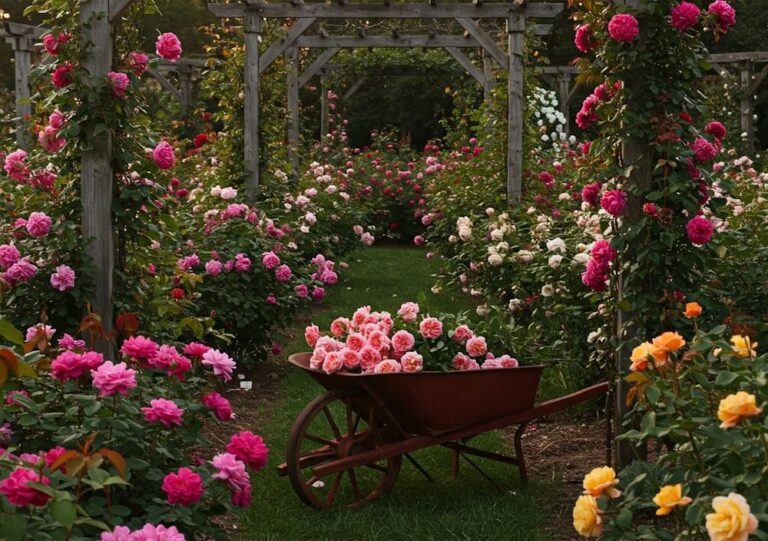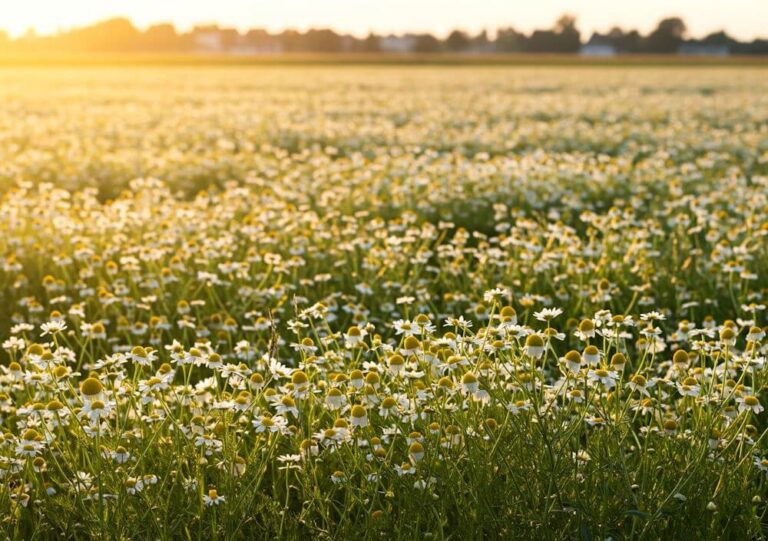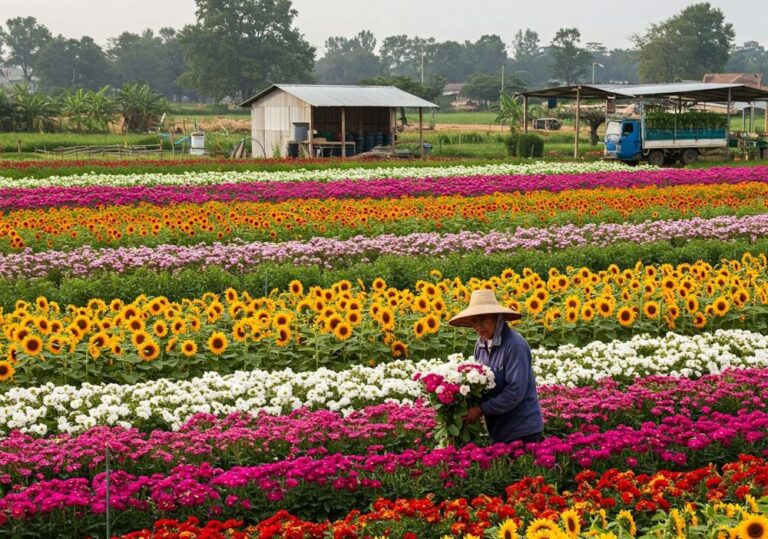Introduction to Annuals and Perennials
In the realm of flower farming, understanding the distinction between annuals and perennials is fundamental to successful cultivation. Annual flowers complete their life cycle within a single growing season. They germinate, bloom, produce seeds, and die all within one year. This rapid turnover allows flower farmers to enjoy frequent blooms and the opportunity for seasonal variety. Examples of popular annuals include marigolds, zinnias, and petunias, each offering vibrant colors and forms that can enhance any floral display.
In contrast, perennials are plants that live for more than two years, providing blooms year after year from the same root system. Their growth patterns are distinct; perennials may bloom in specific seasons and, during their dormant periods, will not display foliage or flowers. However, their ability to return for multiple years makes them a reliable choice for long-term garden designs. Common perennials include daylilies, peonies, and lavender, prized not only for their beauty but also for their durability and resilience in various climates.
The choice between annuals and perennials can significantly impact flower farming strategies. Annuals can offer a continuously changing landscape, ensuring a diverse flourishing throughout the growing seasons. However, they require replanting each year, which can involve significant labor and resources. Conversely, while perennials provide sustainability and lower maintenance costs over time, they necessitate careful planning and consideration of their specific growing requirements. Understanding these fundamental differences will aid flower farmers in making informed decisions that align with their aesthetic goals and resource capabilities.
Defining Annuals: Characteristics and Benefits
Annuals are plants that complete their entire lifecycle within a single growing season. They sprout from seeds, bloom, produce seeds, and die, all within the span of just a few months. This unique characteristic distinguishes them from perennials, which live for multiple years. The brief yet vigorous lifecycle of annual flowers allows for a vibrant display of colors in a relatively short period, making them particularly appealing for flower farming. The ability to replant them every season provides farmers with opportunities to experiment with various species and cultivars, creating diverse floral landscapes that can attract customers.
The benefits of incorporating annuals into a flower farming operation are numerous. One of the most significant advantages is their remarkable range of colors and flower types. Annuals often exhibit bold, vivid hues and diverse forms, making them ideal for both decorative and commercial purposes. Popular examples include zinnias, marigolds, and petunias, all of which are well-known for their striking appearances and abundance of blooms. These factors not only enhance the aesthetic aspect of a flower farm but also contribute to higher potential yields within a single growing season.
Another key advantage of growing annual flowers is their relatively short growth time. Many annuals can go from sowing to flower in just a few weeks, allowing farmers to quickly rotate crops and maximize their production outputs. This free rotation also minimizes the risks of disease accumulation in the soil, promoting healthier growth conditions for the following plantings. Consequently, flower farmers can capitalize on market demands with fresh annual blooms at strategic times throughout the year. Overall, the characteristics and benefits of annuals make them a staple in flower farming, appealing to both growers and customers seeking vibrant floral arrangements.
Understanding Perennials: Characteristics and Benefits
Perennial flowers are a cornerstone of many flower farming operations due to their unique characteristics and multitude of benefits. Unlike annuals, which complete their life cycle in a single growing season, perennials return year after year, providing lasting beauty and sustainability in floral arrangements. This regenerative quality makes them a favorable choice for both commercial flower growers and garden enthusiasts alike.
One of the primary advantages of perennials is their lower maintenance over time. After the initial planting stage, most perennial varieties require less attention compared to their annual counterparts. While annuals need to be replanted every season, perennials establish extensive root systems that allow them to survive harsh conditions and bloom again in the following years. This longevity not only reduces labor costs but also encourages long-term planning and cultivation strategies in flower farming.
Sustainability is another critical benefit associated with perennial flowers. They contribute positively to local ecosystems by providing habitats for pollinators such as bees and butterflies, which are essential for the pollination of many crops. Moreover, perennials often require fewer resources, such as water and fertilizers, once established, thereby lessening the environmental impact of flower farming operations.
Seasonal diversity is also a defining trait of perennials, as they can be selected to bloom at various times throughout the year, ensuring a continuous and vibrant display of color in gardens or commercial settings. Some notable perennial varieties include Echinacea (Coneflower), Rudbeckia (Black-eyed Susan), and Helleborus (Lenten Rose), each offering unique hues and textures that enhance the aesthetic appeal of any floral arrangement.
In conclusion, the characteristics and benefits of perennials make them an excellent choice for flower farming. Their durability, lower maintenance, and contribution to sustainable practices provide a valuable foundation for any floral cultivation effort.
Factors to Consider for Flower Farming
When embarking on flower farming, choosing between annuals and perennials is a decision influenced by several critical factors. Climate conditions are paramount, as different flower species thrive under varying weather patterns. Annuals typically flourish in a broader range of climates due to their quick growth cycles, making them suitable for seasonal flower farmers. In contrast, perennials may require specific climate conditions to establish themselves effectively over multiple years. Understanding the climatic needs of particular flowers is essential for maximizing bloom output throughout the growing seasons.
Soil health also plays a pivotal role in flower farming. Healthy soil contributes nutrients essential for the growth of both annuals and perennials. Farmers should conduct soil tests to determine pH levels, nutrient availability, and organic matter content, which can influence their choice. For instance, while many annuals can adapt to less-than-ideal soil conditions, perennials often demand richer, well-balanced soils for sustainability over the years. Enhancing soil through organic amendments can further benefit both types of flowers and ensure productive growth.
Labor requirements should not be overlooked when making this choice. Annuals often require more labor-intensive management since they are planted anew each season and typically need more frequent watering, fertilization, and pest control. Conversely, perennials can be less labor-intensive once established, as they do not need to be replanted annually. Farmers should consider their available workforce and budget when selecting which type of flowers to cultivate, balancing the immediate labor needs against future farming stability.
Finally, market demand is a significant consideration. Flower farmers must remain adept at understanding consumer preferences and seasonal trends. Annuals often serve immediate consumer needs with a vibrant display of colors, while perennials contribute to ongoing sales opportunities as they establish a more permanent presence in gardens and landscapes. In conclusion, considering climate, soil health, labor, and market demand is crucial for making an informed decision in successful flower farming.
Cost Analysis: Annuals vs. Perennials
When considering the financial aspects of flower farming, a thorough cost analysis of annuals versus perennials is essential. Both types of plants have unique characteristics that influence their initial investment costs, maintenance expenses, and potential revenue generation.
Annuals generally require a higher initial investment compared to perennials. This is primarily due to the need for replanting each year. Farmers must purchase seeds or seedlings every growing season, which can lead to significant costs, especially for large-scale operations. Additionally, annuals often demand more intensive labor and resources in terms of soil preparation, planting, and watering to achieve optimal growth and blooming throughout their short life cycle.
On the other hand, perennials require a higher upfront investment in the first year, but this expense decreases significantly in subsequent years. Once established, perennials typically require less maintenance as they can live for multiple years, providing a more consistent source of blooms. Farmers may find that over time, the cumulative expenses tied to annuals overshadow those of perennials.
Maintenance costs also differ considerably: annuals often necessitate more frequent watering, fertilization, and pest control interventions. Perennials, conversely, may require less frequent attention after the initial establishment period, potentially leading to a more economical operation overall.
Revenue potential is another critical factor in this analysis. Annuals can provide quicker returns on investment due to their rapid growth cycle, allowing for earlier sales. However, perennials can yield higher profits in the long run through multiple bloom cycles without the need for replanting each year.
Ultimately, the choice between annuals and perennials depends on the specific business model and financial goals of the flower farmer. By weighing initial investments, maintenance costs, and revenue potential, farmers can make informed decisions about which type of flower may be the most financially viable for their operations.
Market Trends: Consumer Preferences for Annuals and Perennials
Understanding consumer preferences is crucial for flower farmers aiming to optimize their production strategies. Recent market trends indicate a growing interest in both annuals and perennials, each appealing to distinct segments of the floral market. Annual plants, known for their vibrant blooms and ability to provide quick visual impact, are often favored for seasonal gardens and temporary arrangements. On the other hand, perennials attract consumers seeking long-term solutions that offer sustainability and continuous growth year after year.
According to recent sales data from horticultural industry reports, annual flowers such as petunias, marigolds, and zinnias are experiencing increased demand, particularly in urban gardening and landscaping applications. Their short life cycle and fast production cycle make them an appealing choice for gardeners looking to refresh their outdoor spaces regularly. Floral retailers have noted that consumers are often willing to invest more in annual flower varieties due to their immediate aesthetic returns and versatility in design.
Conversely, perennials, exemplified by plants like coneflowers, daylilies, and peonies, have been gaining traction as eco-conscious consumers prioritize sustainable gardening practices. Perennials not only require less frequent planting but also support local ecosystems by attracting pollinators and providing habitat. In response to this shift, flower farmers are diversifying their offerings, incorporating both annual and perennial varieties to cater to varied customer preferences.
Feedback obtained from consumer surveys further emphasizes this dual interest. Many customers appreciate the opportunity to mix annuals for bold seasonal displays with perennials for their reliability and longevity. This evolving market landscape suggests that flower farmers must adapt to consumer desires by providing a balanced selection of both flower types, ensuring they meet the expectations of a diverse clientele.
Best Practices for Growing Annuals and Perennials
Successfully cultivating annuals and perennials requires adherence to several best practices that promote healthy growth and vibrant blooms. The journey typically begins with meticulous soil preparation, which is essential for both types of flowers. To create an optimal growing environment, the soil should be tested for pH levels and nutrient content, allowing for necessary amendments. Adding organic matter, such as compost, improves soil structure, enhances fertility, and increases moisture retention, thereby benefiting both annuals and perennials.
When it comes to planting, timing plays a crucial role. Annuals are often sown after the last frost, while perennials can be planted in the fall or spring, depending on the species. Proper spacing is vital, as it allows for air circulation and reduces competition for nutrients. Employing various planting techniques—such as grouping flowers by color or size—can not only enhance aesthetic appeal but also encourage beneficial insect activity, which is essential for plant health.
Watering practices need to be adapted to the specific requirements of annuals and perennials. Annuals generally have a shorter root structure and therefore require more frequent watering, especially during dry spells. Perennials, with their deeper root systems, can often tolerate drier conditions once established. However, newly planted perennials should be watered regularly until they are fully rooted. A consistent schedule, ideally early in the morning, minimizes evaporation and promotes maximum absorption.
Pest control is another critical aspect of cultivation. Implementing integrated pest management (IPM) strategies, such as introducing beneficial insects, establishing traps, and using natural insecticidal soaps, helps to mitigate infestations without the detrimental effects of chemical pesticides. Regular inspections of plants not only aid in early detection of potential issues but also contribute to the overall health and robustness of both annuals and perennials.
Lastly, seasonal care tips, such as deadheading spent flowers, mulching to retain moisture, and providing winter protection for perennials, ensure ongoing vitality and encourage repeat blooming. By following these best practices, farmers can cultivate a thriving environment for both annual and perennial flowers, thus ensuring a successful flower farming experience.
Success Stories from Flower Farmers
The choice between annuals and perennials can significantly impact the success of flower farming. To illustrate this, we can look at the experiences of several flower farmers who have opted for one over the other. These stories not only provide valuable insights but also serve as inspiration for those contemplating their own flower farming strategies.
One such success story comes from Emily, a flower farmer located in Oregon, who decided to focus primarily on annuals. After facing the challenge of unpredictable weather patterns, she adapted her planting schedule to ensure a continuous bloom. By employing techniques such as staggered sowing and utilizing high tunnels, Emily successfully extended her growing season. Her dedicated approach resulted in high yields and allowed her to cultivate popular varieties, much to the delight of her local market customers. She emphasizes the importance of understanding market demand when selecting annuals, stating that timely and vibrant blooms can significantly impact sales.
In contrast, there is John, who has chosen to invest in perennials for his flower farm in Minnesota. Initially, John encountered challenges related to the slower establishment period of perennials. However, he committed to nurturing a diverse palette of perennials, which ultimately led to reduced labor costs over time. His strategy involved creating well-planned garden designs that ensured year-round visual appeal and attracted more customers. His experience demonstrates how perennials can be cost-effective long term, as they require less frequent replanting and can thrive in established settings.
These contrasting experiences of Emily and John provide a balanced perspective on flower farming choices. While annuals offer immediate results with vibrant blooms for quick sale, perennials can yield consistent returns with thoughtful planning. Prospective farmers can take inspiration from these narratives, remembering that the right choice ultimately depends on their personal vision, market demands, and regional climate conditions.
Conclusion: Making the Right Choice for Your Flower Farm
Determining whether to cultivate annuals or perennials is a pivotal decision for flower farmers, influenced by various factors such as market demands, available resources, and individual growing conditions. Each type of flower has distinct advantages and challenges that must be considered in alignment with a farmer’s specific goals.
Annuals typically offer an immediate burst of color and diverse options for creating vibrant displays in a single growing season. They can yield quicker profits due to their short growth cycle, making them appealing for farmers intending to maximize revenue in a limited timeframe. Additionally, annuals tend to be more straightforward to manage in terms of weed control and disease issues, allowing for more focused cultivation strategies.
Conversely, perennials provide long-term benefits, as they return year after year, fostering a sustainable approach to flower farming. While they may require a more considerable initial investment in terms of time and resources for planting and establishing, the reduced need for annual replanting can result in lower overall maintenance costs. Perennials also contribute to soil health and support biodiversity, factors that are increasingly important in sustainable farming practices.
Ultimately, the choice between annuals and perennials is contingent upon individual circumstances. Flower farmers should evaluate their market conditions, target customer preferences, and resource availability before making a decision. It is often advantageous to consider a mixed approach that leverages the strengths of both types, thus allowing for a varied and appealing product offering. By understanding the unique characteristics and market potential of annuals and perennials, flower farmers can tailor their strategies to yield the greatest success in their operations.





